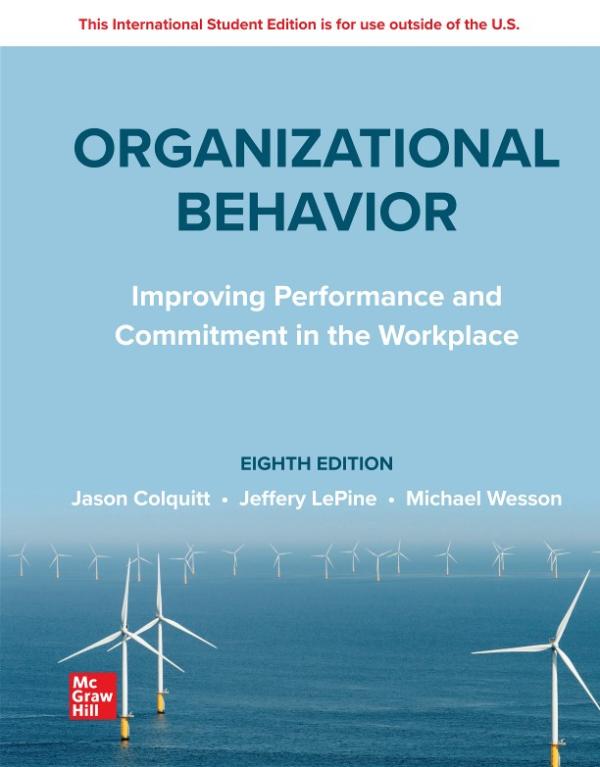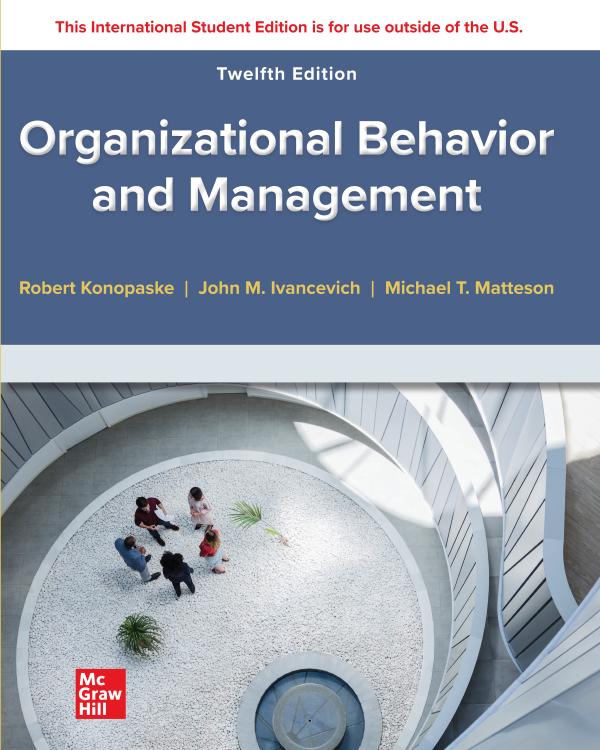
ORGANIZATIONAL BEHAVIOR 8ED
Jason A. Colquitt , Jeffery A. Lepine y Michael J. Wesson
Editorial: McGraw-Hill Higher Education
Edición: 8
Fecha Publicación: 2023
ISBN: 9781265049409
ISBN ebook: 9781265666361
Páginas: 633
Grado: Universitario
Área: Economía y Empresa
Sección: Administración
Idioma: Inglés
 Tweet
Tweet
Edición: 8
Fecha Publicación: 2023
ISBN: 9781265049409
ISBN ebook: 9781265666361
Páginas: 633
Grado: Universitario
Área: Economía y Empresa
Sección: Administración
Idioma: Inglés
 Tweet
Tweet
Cover
Title
Copyright
Dedication
About the Authors
Preface
Acknowledgments
Text Features: OB Insert Boxes
Connect
Additional Resources
Brief Contents
Table of Contents
Part 1: Introduction to Organizational Behavior
Chapter 1: What Is Organizational Behavior?
What Is Organizational Behavior?
Organizational Behavior Defined
An Integrative Model of OB
Does Organizational Behavior Matter?
Building a Conceptual Argument
Research Evidence
So What’s So Hard?
How Do We “Know” What We Know About Organizational Behavior?
Summary: Moving Forward in This Book
TAKEAWAYS
KEY TERMS
DISCUSSION QUESTIONS
CASE: GOOGLE
EXERCISE: IS OB COMMON SENSE?
ENDNOTES
Chapter 2: Job Performance
Job Performance
What Does It Mean to Be a “Good Performer”?
Task Performance
Citizenship Behavior
Counterproductive Behavior
Summary: What Does It Mean to Be a “Good Performer”?
Trends Affecting Performance
Knowledge Work
Service Work
Gig Work
Application: Performance Management
Management by Objectives
Behaviorally Anchored Rating Scales
360-Degree Feedback
Forced Ranking
Social Performance Management
TAKEAWAYS
KEY TERMS
DISCUSSION QUESTIONS
CASE: UBER
EXERCISE: PERFORMANCE OF A SERVER
ENDNOTES
Chapter 3: Organizational Commitment
Organizational Commitment
What Does It Mean to Be “Committed”?
Types of Commitment
Withdrawal Behavior
Summary: What Does It Mean to Be “Committed”?
Trends Affecting Commitment
Diversity of the Workforce
The Changing Employee–Employer Relationship
Application: Commitment initiatives
TAKEAWAYS
KEY TERMS
DISCUSSION QUESTIONS
CASE: AMAZON
EXERCISE: REACTING TO NEGATIVE EVENTS
ENDNOTES
Part 2: Individual Mechanisms
Chapter 4: Job Satisfaction
Job Satisfaction
Why Are Some Employees More Satisfied Than Others?
Value Fulfillment
Satisfaction with the Work Itself
Mood and Emotions
Summary: Why Are Some Employees More Satisfied Than Others?
How Important Is Job Satisfaction?
Life Satisfaction
Application: Tracking Satisfaction
TAKEAWAYS
KEY TERMS
DISCUSSION QUESTIONS
CASE: HILTON
EXERCISE: JOB SATISFACTION ACROSS JOBS
ENDNOTES
Chapter 5: Stress
Stress
Why Are Some Employees More “Stressed” Than Others?
Types of Stressors
How Do People Cope with Stressors?
The Experience of Strain
Accounting for Individuals in the Stress Process
Summary: Why Are Some Employees More “Stressed” Than Others?
How Important Is Stress?
Application: Stress Management
Assessment
Reducing Stressors
Providing Resources
Reducing Strains
TAKEAWAYS
KEY TERMS
DISCUSSION QUESTIONS
CASE: GENERAL MOTORS
EXERCISE: MANAGING STRESS
ENDNOTES
Chapter 6: Motivation
Motivation
Why Are Some Employees More Motivated Than Others?
Expectancy Theory
Goal Setting Theory
Equity Theory
Psychological Empowerment
Summary: Why Are Some Employees More Motivated Than Others?
How Important Is Motivation?
Application: Compensation Systems
TAKEAWAYS
KEY TERMS
DISCUSSION QUESTIONS
CASE: NETFLIX
EXERCISE: EXPLAINING PAY DIFFERENCES
ENDNOTES
Chapter 7: Trust, Justice, and Ethics
Trust, Justice, and Ethics
Why Are Some Authorities More Trusted Than Others?
Trust
Justice
Ethics
Summary: Why Are Some Authorities More Trusted Than Others?
How Important Is Trust?
Application: Social Responsibility
TAKEAWAYS
KEY TERMS
DISCUSSION QUESTIONS
CASE: BEN & JERRY’S
EXERCISE: UNETHICAL BEHAVIOR
ENDNOTES
Chapter 8: Learning and Decision Making
Learning and Decision Making
Why Do Some Employees Learn to Make Decisions Better Than Others?
Types of Knowledge
Methods of Learning
Methods of Decision Making
Decision-Making Problems
Summary: Why Do Some Employees Learn to Make Better Decisions Than Others?
How Important Is Learning?
Application: Training
TAKEAWAYS
KEY TERMS
DISCUSSION QUESTIONS
CASE: CHOBANI
EXERCISE: DECISION-MAKING BIAS
ENDNOTES
Part 3: Individual Characteristics
Chapter 9: Personality and Cultural Values
Personality and Cultural Values
How Can We Describe What Employees Are Like?
The Big Five Taxonomy
Other Taxonomies of Personality
Cultural Values
Summary: How Can We Describe What Employees Are Like?
How Important Are Personality and Cultural Values?
Application: Personality Tests
TAKEAWAYS
KEY TERMS
DISCUSSION QUESTIONS
CASE: BRIDGEWATER ASSOCIATES
EXERCISE: GUESSING PERSONALITY PROFILES
ENDNOTES
Chapter 10: Ability
Ability
What Does It Mean for an Employee to Be “Able”?
Cognitive Ability
Emotional Ability
Physical Ability
Summary: What Does It Mean for an Employee to Be “Able”?
How Important Is Ability?
Application: Hiring High Cognitive Ability Employees
TAKEAWAYS
KEY TERMS
DISCUSSION QUESTIONS
CASE: PEPSICO
EXERCISE: EMOTIONAL INTELLIGENCE
ENDNOTES
Part 4: Group Mechanisms
Chapter 11: Teams: Characteristics and Diversity
Team Characteristics and Diversity
What Characteristics Can Be Used to Describe Teams?
Team Types
Variations Within Team Types
Team Interdependence
Team Composition
Summary: What Characteristics Can Be Used to Describe Teams?
How Important Are Team Characteristics?
Application: Team Compensation
TAKEAWAYS
KEY TERMS
DISCUSSION QUESTIONS
CASE: NISSAN
EXERCISE: PAPER PLANE CORPORATION
ENDNOTES
Chapter 12: Teams: Processes and Communication
Team Processes and Communication
Why Are Some Teams More Than the Sum of Their Parts?
Taskwork Processes
Teamwork Processes
Communication
Team States
Summary: Why Are Some Teams More Than the Sum of Their Parts?
How Important Are Team Processes?
Application: Training Teams
Transportable Teamwork Competencies
Cross-Training
Team Process Training
Team Building
TAKEAWAYS
KEY TERMS
DISCUSSION QUESTIONS
CASE: MAYO CLINIC
EXERCISE: WILDERNESS SURVIVAL
ENDNOTES
Chapter 13: Leadership: Power and Negotiation
Leadership: Power and Negotiation
Why Are Some Leaders More Powerful Than Others?
Acquiring Power
Using influence
Power and Influence in Action
Negotiations
Summary: Why Are Some Leaders More Powerful Than Others?
How Important Are Power and Influence?
Application: Alternative Dispute Resolution
TAKEAWAYS
KEY TERMS
DISCUSSION QUESTIONS
CASE: UPS
EXERCISE: LOBBYING FOR INFLUENCE
ENDNOTES
Chapter 14: Leadership: Styles and Behaviors
Leadership: Styles and Behaviors
Why Are Some Leaders More Effective Than Others?
Leader Decision-Making Styles
Day-to-Day Leadership Behaviors
Transformational Leadership Behaviors
Summary: Why Are Some Leaders More Effective Than Others?
How Important Is Leadership?
Application: Leadership Training
TAKEAWAYS
KEY TERMS
DISCUSSION QUESTIONS
CASE: APPLE
EXERCISE: TAKE ME TO YOUR LEADER
ENDNOTES
Part 5: Organizational Mechanisms
Chapter 15: Organizational Structure
Organizational Structure
Why Do Some Organizations Have Different Structures Than Others?
Elements of Organizational Structure
Organizational Design
Common Organizational Forms
Summary: Why Do Some Organizations Have Different Structures Than Others?
How Important Is Structure?
Application: Restructuring
TAKEAWAYS
KEY TERMS
DISCUSSION QUESTIONS
CASE: PROCTER & GAMBLE
EXERCISE: CREATIVE CARDS, INC.
ENDNOTES
Chapter 16: Organizational Culture
Organizational Culture
Why Do Some Organizations Have Different Cultures Than Others?
Culture Components
General Culture Types
Specific Culture Types
Culture Strength
Maintaining an Organizational Culture
Changing an Organizational Culture
Summary: Why Do Some Organizations Have Different Cultures Than Others?
How Important Is Organizational Culture?
Application: Managing Socialization
TAKEAWAYS
KEY TERMS
DISCUSSION QUESTIONS
CASE: MCDONALD’S
EXERCISE: UNIVERSITY CULTURE
ENDNOTES
Integrative Cases
Glossary/Subject Index
Name Index
Company Index
*La edición digital no incluye códigos de acceso a material adicional o programas mencionados en el libro.
Colquitt, LePine, and Wesson’s, Organizational Behavior 8th edition continues to offer a novel approach that uses an integrative model to illustrate how individual, team, leader, and organizational factors shape employee attitudes—and how those attitudes impact job performance and organizational commitment. This model reminds students where they are, where they've been, and where they're going while elevating two topics that receive less coverage in other books: job performance and organizational commitment. The text also continues to include features that encourage students to see OB concepts playing out all around them, such as OB on Screen, OB at the Bookstore, and OB Assessments.
No hay notas del Autor
Jeffery A. Lepine
No hay notas del Autor
Michael J. Wesson
No hay notas del Autor
MÉTODOS DE COMPRA
* Precios con IVA
Busca el término o términos dentro de cada uno de los libros







